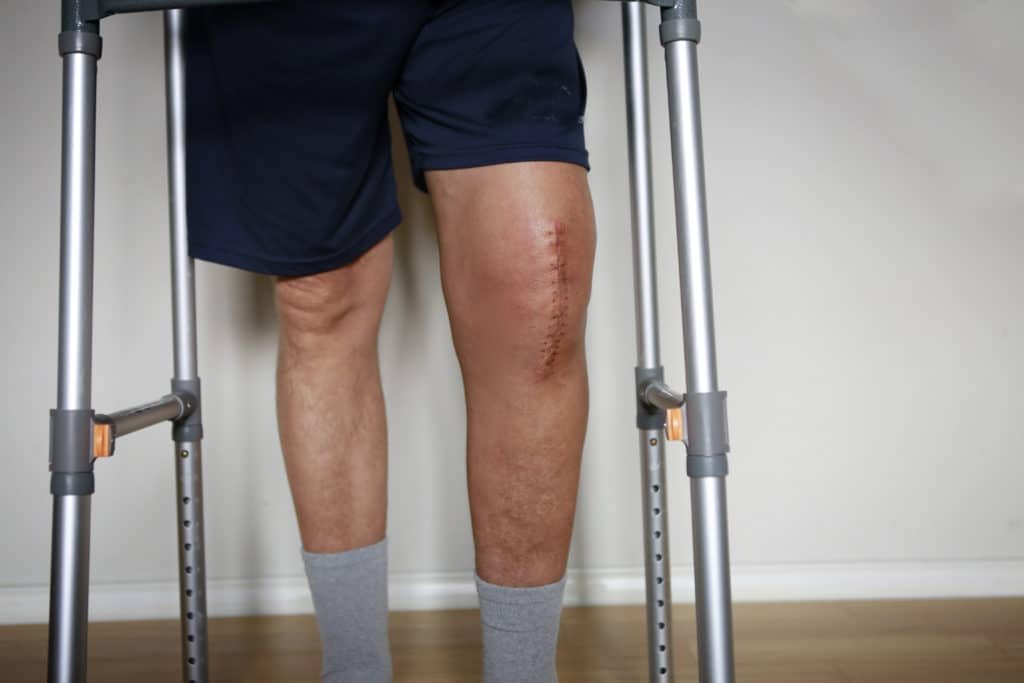Prevention and treatment of blood clots during replacement surgery
DVT in left leg
Blood clots or Deep Vein Thrombosis (DVT) are common among patients that need replacement surgery, so it’s important to understand how to prevent and treat them safely and effectively.
Clotting causes swelling, redness, pain, warmth, and tenderness in one or more areas along the inside of your leg.
Without treatment, a blood clot can cause progress closer to the heart. Emboli (small segments of a clot) can dislodge and block an important artery in the lungs or brain.
Here’s how to prevent blood clots during replacement surgery, as well as the steps you should take if you notice signs of a blood clot after the operation.
1. Ambulation (getting out of bed and walking).
Ambulation with walker after knee replacement
Doctors typically recommend that you walk as soon as possible after hip or knee replacement. Patients can begin with a few steps, for example from their bed to a chair or wheelchair.
As strength improves, patients can then slowly increase their distance and duration of walking until they can walk normally again, usually within four to six weeks after surgery.
Some people may need a walker or a pair of crutches to assist with balance until they are fully ambulatory.
This helps prevent swelling and promotes good circulation in your leg muscles—which is important because one cause of blood clot formation is poor circulation in your extremities.
2. Exercise/physical therapy.
Regular exercise even in bed is essential to a successful recovery after joint replacement. Exercise can speed up recovery time, reduce stiffness, improve flexibility, help relieve stress and aid in weight control.
Exercise also helps blood flow through small blood vessels. A steady blood flow decreases the chance of blood clot formation.
After exercising, it is essential to elevate your legs by keeping them elevated above heart level for at least an hour. This reduces swelling and blood stagnation in veins.
After several months, many people like to increase their level of activity by returning to more demanding sports or outdoor activities.
Avoid long inactivity
If possible, try to avoid air travel within six weeks of your surgery date because air travel can significantly increase your risk of developing deep vein thrombosis.
If you have no other option than air travel and are concerned about developing deep vein thrombosis, speak with your doctor about taking an anticoagulant medication before travel.
An additional preventative measure is avoiding cigarette smoking since smoking increases your risk of developing deep vein thrombosis (DVT).
Additionally, if you are overweight or obese (BMI greater than 30), losing weight before surgery may also help lower your risk of DVT/PE.
3. Compression stockings.
Anti-embolism compression stocking
An easy, inexpensive way to reduce your risk for a blood clot is by wearing compression stockings. These are available at most drugstores and medical supply stores.
The key is getting professional advice from your doctor about properly putting them on and wearing them.
Your doctor might advise you on compression stocking immediately after replacement surgery.
People with diabetes may need special sizing or extra-strength stockings because they have an increased risk for lower-extremity problems due to nerve damage in their legs.
4. Anticoagulant. This is the medicine that prevents blood clots.
The most common anticoagulant given before joint replacement is low molecular weight heparin (LMWH). Heparin works by stopping clotting factors in your blood from forming clots.
During your hospital stay, you will have a regular dose of LMWH injection under your skin. Normally, your injectable anticoagulant will be switched to oral medication once you are discharged.
Warfarin (Coumadin) is another anticoagulant drug that may be prescribed for patients at risk of developing blood clots. Many patients with cardiac conditions are already on Warfarin.
Warfarin is long-acting (action stays for a long time), therefore normally your physician might change it to other short-acting medicines.
Your doctor will monitor your INR levels closely with frequent blood tests to make sure you are getting enough warfarin to prevent clotting but not too much, which could cause bleeding problems.
5. Sequential compression device (SCD) or intermittent pneumatic compression (IPC).
To prevent thromboembolism (blood clot) formation after hip or knee replacement, your healthcare provider may prescribe an SCD or IPC.
This device applies pressure at regular intervals to keep your legs moving and to help push out pooled blood, preventing clots from forming.
The devices can be manually operated (pumping by hand), electrically powered, or battery-operated. An SCD is commonly used in postoperative care after knee replacement surgery; some patients also use one for 3 to 4 weeks following hip replacement surgery.
Research suggests that using an SCD may reduce deep vein thrombosis (blood clot in a vein) formation by more than 60% compared with not using one.
The author follows NICE guidelines for preventing DVT in patients undergoing joint replacement surgery. For more information regarding guidelines please visit NG89 full guideline (nice.org.uk)
All information on this website (https://www.doctor-pal.com) is published in good faith and for general information purposes only. Dr. Indranil Pal does not guarantee the completeness, reliability, or accuracy of this information. Actions based on the information found on this website are entirely at your own risk. Doctor Pal shall not be liable for any loss and/or damage associated with the use of our website. Contact your doctor who can advise you on your health and illness.







